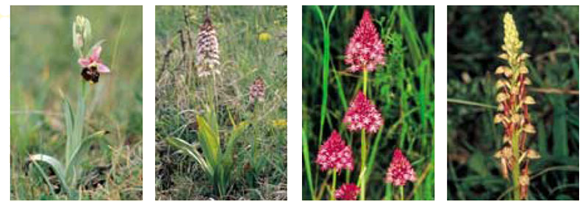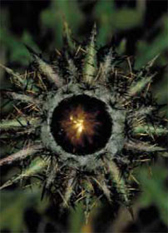 Common Carline Thistle Common Carline ThistleCarlina vulgaris |
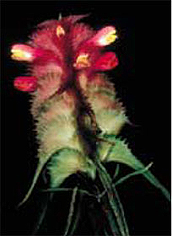 Crested cow-wheat Crested cow-wheatMelampyrum cristatum |
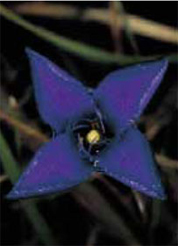 Fringed Gentian Fringed GentianGentianella ciliata |
The protected site of the Aarnescht has a wide range of different rare botanical species. Until today about 171 defined rare species, of those 43 are endangered and protected species of the red list, could be detected. Thanks to the perfect conditions of the site (dryness, paltry soil, rich in lime), the semi arid grasslands of the Aarnescht are particularly favourable to rare botanical species.
Orchids
|
|
|||
| Bee orchid Orphrys holosericea |
Lady orchid Orchis purpurea |
Pyramidal orchid Anacamptis pyramidalis |
Man orchid Aceras anthropophorum |

On the Aarnescht a large number of different kinds of orchids can be found. 23 different species could be indexed, which represents 64 % of the national orchid occurrence.
Propagation strategies
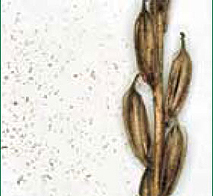 In order to guarantee the reproduction of their species, the orchids generate a great number of tiny little seeds in their cysts, which can easily been carried away by the wind.
In order to guarantee the reproduction of their species, the orchids generate a great number of tiny little seeds in their cysts, which can easily been carried away by the wind.
Orchids: survivalists among the botanicals
Thanks to a special survival strategy, the orchids have adapted themselves to the difficult conditions of a paltry ground. Together with the fungi, they form a kind of joint venture, allowing using the present nutrients at their best.
The orchid seeds normally do not contain nutrients for their germ buds, preventing seeding. The orchid is neutralizing this effect by digesting fungi fibre, entering the cells of the orchid embryo. In this way the orchid can use the nutrients the fungi are absorbing from the vegetable material on the ground. It is only after the complete development of its leaf that the orchid is able to create its own nutrients by the photosynthesis. At this moment it is supplying the fungi with nutrients too.
This form of joint venture is called “symbiosis”. Some kinds of orchids do not produce chlorophylls, which makes them dependent of the root fungi for all their life long. (for example the Bird’s nest orchid / Neottia nidus-avis).

